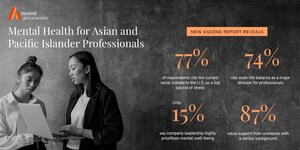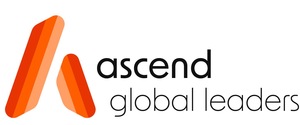Race Trumps Gender in Silicon Valley's Double-Paned Glass Ceiling
New Ascend Foundation study on intersection of race/gender in technology leadership shows scant progress for minorities; Asian women least likely to ascend to top ranks
NEW YORK, Oct. 3, 2017 /PRNewswire/ -- Despite Silicon Valley's focused efforts to improve diversity and inclusion among its workforce, the innovation capital of the United States has not yet delivered on its bold ambitions. The Illusion of Asian Success (www.ascendleadership.org/research), a new report from the Ascend Foundation (www.AscendLeadership.org), a non-profit Pan-Asian career lifecycle organization, spotlights the evolving challenges for Asians, Blacks, Hispanics, and minority women in climbing the professional ladder to success.
Ascend analyzed the leadership pipeline for San Francisco Bay Area technology companies through publicly available data covering 2007-2015. All companies with 100-plus employees are required to file EEOC reports identifying workforce composition by job categories, race and gender. Therefore, the study includes pipeline data aggregated from hundreds of companies, including Apple, Cisco, Facebook, Google, HP, Intel, Twitter, Yelp and others.
While the Bay Area is home to one of the most heterogeneous populations in the U.S., researchers found that diversity in technology leadership roles has generally stagnated over the last decade. Here are some key findings in The Illusion of Asian Success:
- Race is an increasingly more significant impediment than gender to climbing the management ladder, with Asian women and Hispanic women most affected.
- Asians are the least likely to be promoted to managerial or executive positions, in spite of being the largest minority group of professionals and the most likely to be hired. In particular, Asian women are the least represented group as executives, at 66% underrepresentation.
- White men and women are twice as likely as Asians to become executives and hold almost three times the number of executive jobs.
- Even though white women are now substantially more successful in reaching the executive level than ALL minority men or women, white men are still 47% more likely than white women to be executives.
- Both Blacks and Hispanics have declined in their percentage share of the professional workforce despite efforts to hire more underrepresented minorities.
"When we used the Executive Parity Index to compare the numbers of minorities as executives to their numbers in the workforce, it was clear that that efforts to promote more Asians, Blacks, and Hispanics have made no meaningful impact to the minority glass ceiling," said Buck Gee, a former vice president and general manager at Cisco Systems who is an Ascend executive advisor and a study co-author. "That said, we saw progress made by white women, so we know tech companies can change. Now it's time to do the same for minority men and women."
Co-author and Ascend executive advisor Denise Peck, a former vice president at Cisco, stated, "Minority women continue to bump against a double-paned glass ceiling. The data show that a general focus on developing women leaders has not addressed the distinct challenges for Asian, Black, or Hispanic women. This has been an unspoken truth in the minority community, and we hope that our report opens a long overdue dialogue. We encourage all companies to take a hard look at their minority pipeline and ask how they can do better."
"In spite of companies investing in their recruiting and hiring of Asians, Blacks and Hispanics, advancement to senior corporate ranks and corporate boards is still highly limited," said Anna Mok, executive vice president and national board member of Ascend. "To make the systemic changes that positively impact and advance results, CEOs, their executive teams, and corporate boards need to actively lead change and drive solutions."
How is Your Company Addressing Diversity?
Ascend offers two simple tools to help companies determine if they have a leadership diversity imbalance. The Executive Parity Index™ (EPI) scores a company's diversity in its executive workforce relative to its entry-level workforce. The new Management Parity Index™ (MPI) helps assess the flow of diversity from the ground floor to middle management. Just plug your most recent EE0-1 data into the calculators to determine your MPI and EPI.
Download a free copy of The Illusion of Asian Success: Scant Progress for Minorities in Cracking the Glass Ceiling from 2007-2015 from the Ascend website at www.ascendleadership.org/research.
About Ascend Foundation and Ascend®
Ascend Foundation is a 501(c)(3) organization with a mission to educate, advocate, and enable Pan-Asian business leaders to reach their full potential and provide scholarships to honor students who demonstrate scholastic excellence, leadership, and commendable community service. Ascend (@AscendLeader) is the largest, non-profit Pan-Asian membership organization for business professionals in North America. Established in 2005, Ascend, a career lifecycle organization, reaches 60,000+ senior executives, professionals, and MBA/undergraduate students involved in its 50+ chapters in the United States and Canada. Visit http://www.ascendleadership.org for more information.
©2017 Ascend Foundation. Executive Parity Index (EPI) and Management Parity Index (MPI) are trademarks of Ascend Foundation. All rights reserved.
Contact:
Sofia Poyhonen, PR Manager, (212) 248-4888 x111, [email protected]
Lisa Hawes, Sterling Communications, (408) 884-5155, [email protected]
SOURCE Ascend Foundation
Related Links
WANT YOUR COMPANY'S NEWS FEATURED ON PRNEWSWIRE.COM?
Newsrooms &
Influencers
Digital Media
Outlets
Journalists
Opted In






Share this article